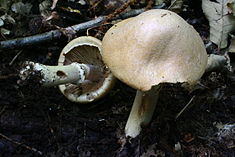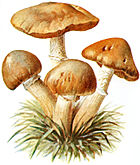- Cortinarius caperatus
-
Cortinarius caperatus Scientific classification Kingdom: Fungi Division: Basidiomycota Class: Agaricomycetes Order: Agaricales Family: Cortinariaceae Genus: Cortinarius Species: C. caperatus Binomial name Cortinarius caperatus
(Pers.) Fr. (1838)Synonyms Rozites caperata (Pers.) P. Karst. Pholiota caperata (Pers.) Sacc. Dryophila caperata (Pers.) Quél. Togaria caperata (Pers.) W.G. Sm.
Cortinarius caperatus Mycological characteristics 
gills on hymenium 

cap is convex
or umbonate
hymenium is adnate 
stipe has a ring 

spore print is ochre
to brown
ecology is mycorrhizal 
edibility: edible Cortinarius caperatus, commonly known as the gypsy mushroom, is a highly esteemed edible mushroom of the genus Cortinarius found in northern regions of Europe and North America. It was known as Rozites caperata for many years, before genetic studies revealed it lay within the large genus Cortinarius. The ochre-coloured fruiting bodies appear in autumn in coniferous and beech woods, as well as heathlands in late summer and autumn. The gills are free and clay-coloured and the smell and taste mild. Although mild-tasting and highly regarded, the gypsy mushroom is often infested with maggots.
Contents
Taxonomy
The gypsy mushroom has a checkered taxonomic history. It was originally described as Agaricus caperatus by mycologist Christian Hendrik Persoon in 1796, before being transferred to the genus Cortinarius by the Swedish mycologist Elias Magnus Fries. Later it was transferred to Pholiota in 1887 by Pier Andrea Saccardo, and then Rozites (after mycologist Ernst Roze) by Finnish mycologist Petter Adolf Karsten in 1879, and was known as Rozites caperata (Pers.) P. Karst. for many years before genetic study once more placed it within Cortinarius in 2002.[1][2] The variant Rozites caperatus was and is also sometimes seen, but this may be a mistake.[3] The specific epithet caperatus is Latin for “wrinkled”.[4]
Common names include the gypsy mushroom,[5] and wrinkled rozites.[6] An unusual common name is granny′s nightcap in Finland.[4]
Description
Cortinarius caperatus has a buff to brownish-ochre cap 5–10 cm (2–4 in) diameter, which is covered with whitish fibres. The surface has a wrinkled and furrowed texture.[6] It may have a lilac tinge when young. It is convex initially before expanding and flattening with a boss in the centre. The stipe is 4–7 cm (1.6–2.6 in) high and 1–1.5 cm (0.4–0.6 in) thick and slightly swollen at the base, and is whitish with a whitish ring, which is initially attached to the cap. The free gills, are clay-coloured; the spores give an ochre-brown spore print. The warty almond-shaped spores measure 10–13 × 8–9 µm. The flesh is cream-coloured and the taste mild.[7]
Similar-looking North American species include Agrocybe praecox, which lacks the wrinkled cap, and is found in cultivated areas, and Phaeolepiota aurea, which has powdery-granular surface.[5] In central Europe, old specimens could be mistaken for the highly poisonous Inocybe erubescens in summer, and young mushrooms for the inedible Cortinarius traganus, although the latter is readily distinguished by its unpleasant odour.[8]
Distribution and habitat
It is found across northern Europe, mainly in Scandinavia. In the British Isles it is uncommon outside the Scottish Highlands[4] and the New Forest.[9] It is widely found in northern parts of North America.[5] The Gypsy also grows in temperate Asia, i.e. it can be found on the markets in the Tibetan areas of Yunnan and Sichuan and also in Bhutan. In addition to the Gypsy, in the Tibeto-Himalayan region the Himalayan Gypsy (Cortinarius / Rozites emodenis), a close relative with a purple hue, is also commonly eaten and frequently traded.[10]
Fruiting bodies sprout from August to October in conifer and beech woods, as well as heather (often close by sphagnum) in Scotland. It is mycorrhizal but non-selective in its hosts.[4] It prefers sandy soils and avoids chalky ones, and may be found in the same habitats as Boletus badius, Paxillus involutus, and chanterelles.[11] It is often found near huckleberry in North America.[5]
Edibility
Cortinarius caperatus is a highly regarded edible mushroom with a mild flavour. It is said to mix well with stronger-flavoured fungi such as chanterelles, boletes, brittlegills or milk-caps.[4] However, picked mushrooms are often infested with maggots.[11] Mycologist David Arora recommends discarding the tough stipes.[5] It can be dried for later use readily.[6]
It is sold commercially in Finland.[12]
This mushroom is known to hyperaccumulate heavy metals from its environment. Following the Chernobyl_disaster, resulting in radioactive contamination in countries as distant as Scandinavia, health autorities in these countries caution against overconsumption of C. capertatus.
See also
References
- ^ Peintner U, Horak E, Moser M, Vilgalys R. (2002). "Rozites, Cuphocybe and Rapacea are taxonomic synonyms of Cortinarius: New combinations and new names". Mycotaxon 83: 447–51.
- ^ Peintner U, Horak E, Moser M, Vilgalys R. (2002). "Phylogeny of Rozites, Cuphocybe and Rapacea inferred from ITS and LSU rDNA sequences". Mycologia 94 (4): 620–29. doi:10.2307/3761713. JSTOR 3761713.
- ^ See for instance the Species Fungorum entry and the Mushroom Expert entry. The genus name Rozites is a construction based on the name Roze (after mycologist Ernst Roze) and it is difficult to know whether it should be masculine or feminine.
- ^ a b c d e Nilson S, Persson O. (1977). Fungi of Northern Europe 1: Larger Fungi (Excluding Gill-Fungi). Penguin. p. 86. ISBN 0-14-063005-8.
- ^ a b c d e Arora D. (1986). Mushrooms Demystified: a Comprehensive Guide to the Fleshy Fungi (2nd ed.). Berkeley: Ten Speed Press. p. 412. ISBN 0-89815-169-4.
- ^ a b c Lamaison J-L, Polese J-M. (2005). The Great Encyclopedia of Mushrooms. Könemann. p. 138. ISBN 3-8331-1239-5.
- ^ Phillips R. (2006). Mushrooms. Pan MacMillan. p. 207. ISBN 0-330-44237-6.
- ^ Zeitlmayr L. (1976). Wild Mushrooms:An Illustrated Handbook. Garden City Press, Hertfordshire. p. 79. ISBN 0-584-10324-7.
- ^ Fungal Records Database for the British Isles http://www.fieldmycology.net/GBCHKLST/gbsyns.asp?intGBNum=34829
- ^ Winkler, D. 2008: The Mushrooming Fungi Market in Tibet exemplified by Cordyceps sinensis and Tricholoma matsutake. In: JIATS 4 (December 2008), In the Shadow of the Leaping Dragon: Demography, Development, and the Environment in Tibetan Areas. THL #T5571, 46 pp., http://www.thlib.org/collections/texts/jiats/#jiats=/04/winkler/
- ^ a b Haas H. (1969). The Young Specialist Looks at Fungi. Burke. p. 124. ISBN 0222794143.
- ^ Pelkonen R, Alfthan G, Järvinen O. (2008). Element Concentrations in Wild Edible Mushrooms in Finland. Helsinki: Finnish Environment Institute. p. 32. ISBN 978-952-11-3153-0. http://www.ymparisto.fi/download.asp?contentid=87635. Retrieved 2009-02-20.
Categories:- Cortinariaceae
- Fungi of Europe
- Fungi of North America
- Edible fungi
Wikimedia Foundation. 2010.


